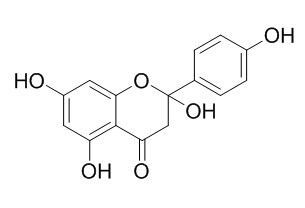2-Hydroxynaringenin
The recombinant protein exhibits high FNS I activity catalyzing the conversion of naringenin to apigenin and 2-Hydroxynaringenin.
Inquire / Order:
manager@chemfaces.com
Technical Inquiries:
service@chemfaces.com
Tel:
+86-27-84237783
Fax:
+86-27-84254680
Address:
1 Building, No. 83, CheCheng Rd., Wuhan Economic and Technological Development Zone, Wuhan, Hubei 430056, PRC
Providing storage is as stated on the product vial and the vial is kept tightly sealed, the product can be stored for up to
24 months(2-8C).
Wherever possible, you should prepare and use solutions on the same day. However, if you need to make up stock solutions in advance, we recommend that you store the solution as aliquots in tightly sealed vials at -20C. Generally, these will be useable for up to two weeks. Before use, and prior to opening the vial we recommend that you allow your product to equilibrate to room temperature for at least 1 hour.
Need more advice on solubility, usage and handling? Please email to: service@chemfaces.com
The packaging of the product may have turned upside down during transportation, resulting in the natural compounds adhering to the neck or cap of the vial. take the vial out of its packaging and gently shake to let the compounds fall to the bottom of the vial. for liquid products, centrifuge at 200-500 RPM to gather the liquid at the bottom of the vial. try to avoid loss or contamination during handling.
Ulm University Medical Center2020, doi: 10.18725.
ACS Synth Biol.2022, 11(10):3296-3304.
Plants (Basel).2023, 12(5):1120.
Life Sci.2022, 298:120488.
Agronomy2022, 12(10), 2426.
Nutrients.2024, 16(20):3521.
Pharm Biol.2016, 54(7):1255-62
Molecules2022, 27(9):2827.
J Nat Prod.2022, 85(5):1351-1362.
Antibiotics.2022, 11(4), 510.
Related and Featured Products
FEBS Lett. 2014 Jun 27;588(14):2307-14.
Functional characterization of a Plagiochasma appendiculatum flavone synthase I showing flavanone 2-hydroxylase activity.[Pubmed:
24859082]
FNS I is a 2-oxoglutarate dependent dioxygenase (2-ODD) found mainly in species of the Apiaceae family.
METHODS AND RESULTS:
Here, an FNS I cDNA sequence was isolated from the liverwort Plagiochasma appendiculatum (Aytoniaceae) and characterized. The recombinant protein exhibited high FNS I activity catalyzing the conversion of naringenin to apigenin and 2-Hydroxynaringenin. The critical residue for flavanone-2-hydroxylation activity was Tyr240, as identified from homology modeling and site-directed mutagenesis. The recombinant protein also showed some flavonol synthase activity, as it can convert dihydrokaempferol to kaempferol. When the Leu311 residue was mutated to Phe, the enzyme's capacity to convert dihydrokaempferol to kaempferol was substantially increased.
CONCLUSIONS:
PaFNS I represents a 2-ODD in which a hydrophobic π-stacking interaction between the key residue and the naringenin A-ring determines 2-hydroxyflavanone formation.



